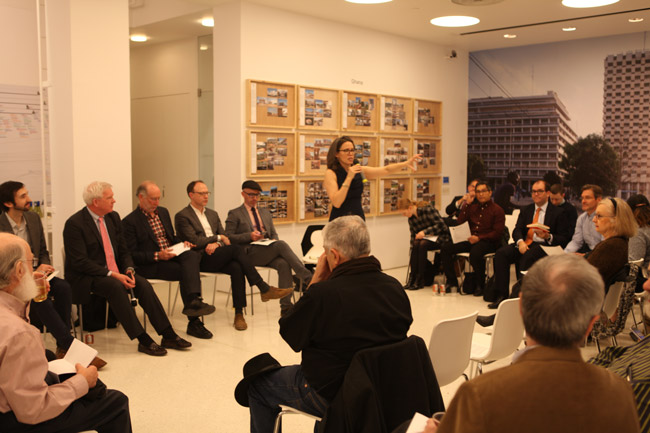by: Ian Grohsgal
On 02.22.17 at the Center for Architecture, the AIANY Social Science and Architecture Committee held the first event in a series, titled Hesitations and Constraints, on how social research informs varying building typologies. The discussion sought to uncover, or at least clarify, the reasons behind the varying degrees of interest in social research from different typologies as well as the possible solutions for increasing the value of research.
The event was structured like a roundtable in order to generate greater discussion among the panelists and encourage participation from the audience. The moderator, Eve Klein, Assoc. AIA, co-founder of the AIANY Social Science and Architecture Committee, led the discussion with panelists James Berge, AIA, LEED AP, Principal, Regional Leader of Science and Technology, HOK; Enrico Cullen, Director, Strategy, a.i.r. nyc; Jacob Dugopolski, AIA, AICP, LEED AP, Associate, WXY architecture + urban design; Alex O’Briant, Associate Partner, Ennead Architects; and Stephen Yablon, AIA, LEED AP, Principal, Stephen Yablon Architecture. Each of the panelists approached the discussion from a distinct angle, bringing their expertise and experiences to the fore. Berge brought his expertise of designing for workplaces within the scientific research community to foster greater collaboration. Cullen sought to illuminate where policy limitations still exist in transforming an idea into reality when dealing with public and private clients. Dugopolski showed how social research could inform the built environment at scale, from zoning to master planning. O’Briant discussed the successful incorporation of social research into educational projects such as the Seoul Foreign School and the Engineering Flex Lab for Purdue University. Harking back to the committee’s 2016 Program Cubed event featuring Yablon, the conversation articulated how healthcare is a typology that sees both the benefits and value of incorporating social research into architectural projects.
Beginning the conversation from a broad perspective, the panel sought to define the concept and type of social research, distinguish the type of research, and indicate the tools by which the research is conducted. Berge separated research into two parts: problem seeking and problem solving. In order for research to be effective, he maintained that “we must understand the problem that we are trying to solve really well before starting to design.” To bring home his point, he alluded to Ansel Adam’s quote: “there’s nothing worse than a sharp image of a fuzzy concept.”
Clarifying where research lies within the design process, Yablon suggested that research and programming should be considered synonymous within the larger category of what he defined as the “problem designing phase.” He also pointed out that architects already conduct programmatic, site, building technology, and material research throughout the design process. This is, however, quite different from the research that the Social Science and Architecture Committee is seeking to address, which is social science research. Traditionally, social science research has been less tangible and harder to quantify. Part of the Social Science & Architecture Committee remit, however, has been to explore and identify new sources for understanding the relationship between people and space. For instance, Dugopolski shared new methods for gathering people research by identifying the tools of research from his experience at WXY Studio. There he currently explores how to synthesize data from tools such as online commenting and individual interviews into an overarching design statement.
More than just defining research, the panel also distinguished typologies by their degree of support towards research as well as uncover methods for persuading clients of the value of research. Specifically, what is unique about healthcare, medicine or education that makes them value social data in a way that allows them to better integrate it into the design process? The medical industry, an example cited by Berge, leverages social research and people data to provide better health services, such as utilizing wearables that monitor a patient’s health. To convince those within other typologies of the value of social research in architecture, the panel agreed that designers must articulate how research influences design, the success of the project, and the success of the occupants. This ability to measure success and ‘return on investment’ requires raising the value of social science research and architectural outcomes, appraising the long-term financial return of the research.
The myths that were busted that night were twofold. First, for the applications of social science research to be incorporated into design, cross-disciplinary partnership is critical. Second, strong research and numbers do not guarantee that a client with follow or even support research. To convince people of the value of research, designers need to deliver strong data through a compelling narrative. In the words of the exemplary orator, Abraham Lincoln, “In order to win a man to your cause, you must first reach his heart, the great high road to his reason.”
Event: Myth Busters: How Social Research Serves Different Typologies
Location: Center for Architecture, 02.22.17
Speakers: James Berge, AIA, LEED AP, Principal, Regional Leader of Science and Technology, HOK
Enrico Cullen, Director, Strategy, a.i.r. nyc
Jacob Dugopolski, AIA, AICP, LEED AP, Associate, WXY architecture + urban design
Alex O’Briant, Associate Partner, Ennead Architects
Stephen Yablon, AIA, LEED AP, Principal, Stephen Yablon Architecture
Moderator: Eve Klein, Assoc. AIA, Co-founder and Co-chair, AIANY Social Science and Architecture Committee
Organized by: AIANY Social Science and Architecture Committee










